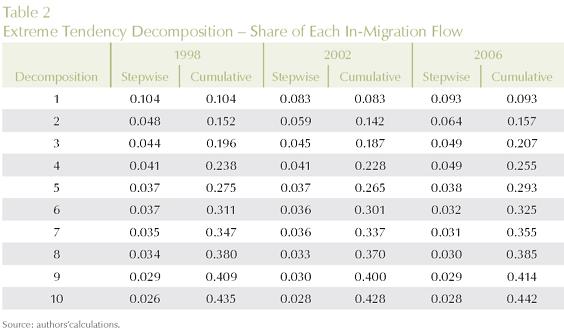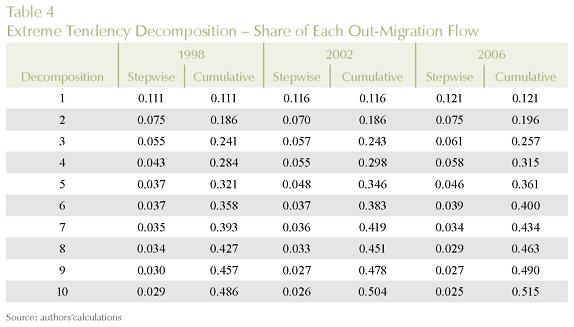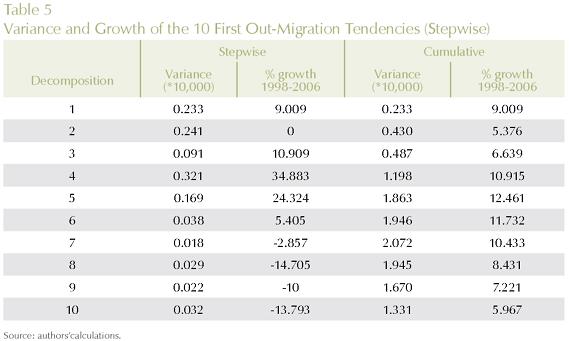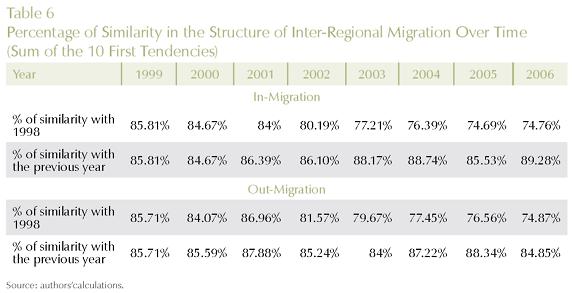Servicios Personalizados
Revista
Articulo
Indicadores
-
 Citado por SciELO
Citado por SciELO -
 Accesos
Accesos
Links relacionados
-
 Citado por Google
Citado por Google -
 Similares en
SciELO
Similares en
SciELO -
 Similares en Google
Similares en Google
Compartir
Ensayos sobre POLÍTICA ECONÓMICA
versión impresa ISSN 0120-4483
Ens. polit. econ. v.27 n.58 Bogotá ene. 2009
ESTRUTURA DOS FLUXOS MIGRATÓRIOS INTER-REGIONAIS NA ESPANHA: 1998-2006
ESTRUCTURA DE LOS FLUJOS MIGRATORIOS INTERREGIONALES EN ESPAÑA: 1998-2006
STRUCTURE OF INTERREGIONAL MIGRATION FLOWS IN SPAIN: 1998-2006
Sandy Dall'erba Dong Guo*
* Os autores são, em sua ordenm: Do departamento de geografia e desenvolvimento regional, Universidade de Arizona e do departamento de economia regional de aplicações em laboratório, Universidade de Illinois em Urbana- Champaign, USA.
Diretor de ciência, tecnologia e indústria, OECD. 2rue André-Pascal, 75775 Paris, Cedex 16, Francia.
Correis electrónicos:
dallerba@email.arizona.edu
Dong.GUO@oecd.org
Documento recebido no dia 17 de julho de 2008; versão final aceita no dia 13 de dezembro de 2008.
* Los autores son en su orden:
Departamento de Geografía y Desarrollo Regional, Universidad de Arizona y el Laboratorio de Aplicaciones Regional de Economía de la Universidad de Illinois en Urbana-Champaign, EE.UU.
Dirección de Ciencia, Tecnología e Industria, la OCDE, 2rue André-Pascal, 75775 Paris, Cedex 16, Francia.
Correos electrónicos:
dallerba@email.arizona.edu
Dong.GUO@oecd.org
Documento recibido 17 de junio de 2008; versión final aceptada 13 de diciembre de 2008.
* The authors are respectively:
Dept. of Geography and Regional Development, University of Arizona and Regional Economics Applications Laboratory, University of Illinois at Urbana-Champaign, USA.
Directorate for Science, Technology and Industry, OECD, 2, rue André-Pascal, 75775 Paris, CEDEX 16, France.
E-mails:
dallerba@email.arizona.edu
Dong.GUO@oecd.org
Document received 17 june 2008; final version accepted 13 december 2008.
O propósito deste artigo é realizar uma pesquisa exploratória da estrutura dos fluxos migratórios inter-regionais na Espanha durante o período 1998-2006. Aplicou-se a decomposição de tendências extremas de Sonis (1980) aos fluxos migratórios matriciais. Encontrou-se que a estrutura migratória inter-regional na Espanha se fez menos complexa durante o período analisado, mas seus lugares de origem e destino permaneceram constantes.
Classificação JEL: C67, R15, R23.
Palavras chave: regiões, migração, decomposição.
El propósito de este artículo es realizar una investigación exploratoria de la estructura de los flujos migratorios interregionales en España durante el período 1998 a 2006. Se aplicó la descomposición de tendencias extremas de Sonis (1980) a los flujos migratorios matriciales. Se encontró que la estructura migratoria inter-regional en España se hizo menos compleja durante el período analizado y que sus lugares de origen y destino han permanecido constantes.
Clasificación JEL: C67, R15, R23.
Palabras clave: regiones, migración, descomposición.
The purpose of this paper is to perform an exploratory investigation of the structure of inter-regional migration flows across Spanish regions between 1998 and 2006. We apply Sonis' (1980) extreme tendency decomposition to the flow matrices to reveal that the structure of inter-regional migration in Spain is becoming less complicated over time but the places of origin and destination have remained very similar.
JEL Classification: C67, R15, R23.
Keywords: regions, migration, decomposition.
I. INTRODUCTION
Inter-regional migration in Spain has grown by 85% between 1998 and 2006, while the Spanish population has grown by only 9% over the same period. Numerous authors have focused on exploring the reasons for inter-regional migration in Spain (Bover and Velilla, 2002; Antolin and Bover, 1997), but seldom have efforts been made to uncover the pattern of migration changes. Hence, in this paper we propose to explore the structure of inter-regional migration by checking whether it has become more or less complex over time. If we define complexity as the number and strength of interaction flows, we hypothesize that the level of complexity should increase over time as transportation and information costs decrease. Increasing complexity reflects a situation where the majority of migration takes place between a relatively small set of regions first and then evolves to a situation where most or all the regions of the system are involved, thus reducing the share of each flow in total migration.
The interest of this methodology is twofold. Firstly, categorizing the level of interactions between regions may be "the most useful indicators of the strength, the growth dynamics, or the development path of an economy" (Jackson, Hewings and Sonis, 1989). For instance, if we discover that migration flows between a small set of regions represent a large part of total flows, we would know much more about their characteristics vis-à-vis other regions with similar levels of development. Secondly, if the exercise is repeated over several time periods, it may become an invaluable tool in highlighting the flows which are always present and/or predicting future changes in the structure of an economy. This is particularly important when funding for updating a migration matrix (or, as noted by Jackson et al., 1989, an input-output table) is not available.
In this paper, we explore the level of complexity of yearly migration flows between 1998 and 2006. For that purpose, we rely on push-pull flow decomposition by Sonis (1970, 1980, 1982 and 1988) which will be described in Section II. In Section III we apply the decomposition to several matrices of yearly migration flows. Firstly, we differentiate pulled-migration from pushed-migration patterns and check whether there is consistency in their places of origin and destination. The last section provides some summary interpretation of the findings.
II. FLOW DECOMPOSITION: THE PUSH-PULL ANALYSIS
In order to get some insights into the structure of flows, we use the push-pull flow decomposition method, which is based on the superposition principle. It provides a way of decomposing a flow matrix into a weighted sum of sub-flows, also called extreme tendencies, and hierarchically orders them according to their degree of importance (Guo, Hewings and Sonis, 2005; Jackson et al., 1989; Sonis, 1980). In addition, it is a useful tool for measuring the degree of complexity of an economy, where, according to Jackson et al. (1989), the degree of complexity reflects the degree of sectoral intermediate production interactions in an economy. Obviously, Jackson et al. (1989) applied their work to an inter-regional input-output table. The larger the first weight, the less complex the economy; but this might also be true up to a certain level, at the end to say the third level. A greater proportion of the total flows will be accounted for by the initial levels in a simple economy reflecting the fewer interactions among production sectors. In a very simple economy with few interactions, the number of levels in the hierarchy would be small and the value of the first tendency would be large. The more complex the inter-regional relationships become, the more the necessary degree of interaction and the corresponding number of levels in the hierarchy increase, while the value of the first tendency decreases.
Formally, a given flow matrix Y can be rewritten as a weighted sum of some extreme tendencies matrices:

X. represents the extreme optimization tendencies, acting simultaneously with the matrix of actual flows, and the weights p. represent the measure of realization of these tendencies in an actual flow matrix according to the superposition principle. In this fashion, each extreme tendency describes the inter-sectoral relationship in each hierarchically decomposed level and the successively decreasing weights indicate the decreasing contribution of each additional set of flows in the hierarchy. Each value represents the 7th decomposition and may be calculated using either rows (out-migration or pushed-migration to respect the pull-push terminology) or columns (in-migration or pulled-migration). For instance, the first weight (or tendency) of the in-migration (out-migration) decomposition is based on the percentage of each flow by column (or row) and equals the smallest of the greatest percentages by columns (rows).
In a very simple system, each region would send workers to only one other region while receiving migrants from only one region. However, most migration matrices have much more sophisticated systems of intermediation with in-migration and outmigration relationships involving multiple regions. The superposition principle attempts to separate out this complexity into a hierarchically ordered set of relations where, at each level, interactions are restricted to the simple set, i.e. each region has interaction with only one other region.
Graph 1 shows the possible changes in the values of the weights for one economy over time as this economy becomes more complicated, in the sense that the degree of interaction increases.
III. DECOMPOSING INTERREGIONAL MIGRATION FLOWS
We use the migration matrices between the fifty-two Spanish NUTS31 regions between 1998 and 2006. Data for previous or more recent years are not available. The eight matrices come from the National Statistical Office of Spain (INE). The primary matrices differentiate migration flows of Spaniards from those of foreigners after 2002, but we decided not to use this split for consistency with the data prior to 2002. In this section, the matrices after 2002 correspond to inter-regional migration flows regardless of one's nationality. It also means that intra-regional migration, which represents around 60% of each year's total flows, has been deleted.
Table 1 above indicates which were the most and least attractive / repulsive Spanish regions in 2006. As noted by Bover and Velilla (2002), the level of in- and out-migration flows of a region is positively correlated with its population, therefore Madrid and Barcelona are the two largest places of origin and destination for migrants. A couple of other factors such as family ties (Bover and Velilla, 2002), lifecycle effects such as retirement (Mincer, 1978) or climate and amenities (Cushing, 1987) could be studied to explore the reasons for migration in Spain, but this is not the focus of our paper. Indeed, such an approach would not give us any insight on the structure of migration flows and whether this structure is becoming more complex over time.
We therefore apply Sonis (1980) decomposition method and start with in-migration, i.e. the analysis of the columns of the migration matrices. The results of the decomposition of the 10 first extreme tendencies are presented in Table 2 below for three years, 1998, 2002 and 20 062. In addition, Table 3 shows the variance over the whole period and the growth between 1998 and 2006 of each tendency. Several results are worth discussing Firstly, the share of the first extreme tendency has reduced by 10.5% over time indicating that the importance of the largest in-migration flow has decreased or that the migration patterns have become more complicated. However, when looking at the cumulated 10 most extreme tendencies, they have slightly increased (from 43.5 % in 1998 to 44.2% in 2006). We stopped the calculations at the 10 first tendencies because these already cover about 50% of the total flow. On the other hand, each successive level in the hierarchy (eleventh, twelfth, etc) would contribute less than 2.6% to the total flow of interactions across regions.
As a result, conclusions on the level of complexity of in-migration flows depend on how many extreme tendencies one is willing to look at. We are aware that this is one of the flaws of this methodology. However, as Table 3 indicates, except for the first tendency, the growth of the cumulated tendencies is always positive, thus reflecting an increasingly less complex structure of in-migration over time.
Finally, while the growth rate only captures the evolution of each tendency between the initial and final period, we included in Table 3 the variance of each tendency over the whole period. The results indicate that the two most important flows are those which evolved the most over time. The variance of the cumulated tendencies is systematically greater than each tendency because it includes the greater variance of the two first tendencies.
The results for out-migration patterns are presented in Tables 4 and 5 and show a slightly different story than above. Firstly, the importance of the first tendency is larger for out-migration than for in-migration (12.1% vs. 9.3% in 2006) which indicates that out-migration is less complex than in-migration. The level of complexity of out-migration has decreased over time whether one focuses on the largest tendency (+9%) or any of the cumulated tendencies (+5.9% for the cumulated 10 first tendencies). We also note that lower levels of the hierarchy display slightly greater variances than the higher levels, thus indicating that these last ones are more predictable.
What do all these results mean? Going back to our original idea described in the intraduction and Section II, the results of the cumulated tendencies tell us that the interregional migration flows in Spain are getting less complicated over time. The change is not necessarily dramatic (+1.6% for in-migration and +5.9% for out-migration if one focuses on the 10 first tendencies) but the study period is not very long either. As noted in Jackson et al. (1989), the information we draw on for the migration dynamics from this approach could reveal itself a very useful tool when updating migration matrices, in the absence of funding to collect true data.
While Sonis (1980) decomposition methodology gives us an idea of the overall structure of migration flows and of their evolution over time, it does not give us any indication as to whether these are the same flows (characterized by the same origin and destination) one is looking at. In order to identify the flows which are always present in the structure of migration we rely on the results of Table 6 below. They represent the percentage of flows that are similar to those of the year 1998 and to those of the previous year. All the calculations are based on the sum of the first 10 tendencies3. The fact that a rather large share of the flows (around 83%) does not change over time tells us that there is a "fundamental structure" of migration, i.e. it is relatively easy to predict where people want to move if one knows where they live. This concept was introduced by Simpson and Tsukui (1965) in the case of trade, as they also discovered some persistent flows in their input-output tables.
IV. CONCLUSIONS
This paper aims to conduct an exploratory analysis of the inter-regional migration pattern in Spain from 1998 to 2006. The methodology applied is a pull-push analysis developed by Sonis (1980). By decomposing the flow matrix as a weighted sum of hierarchy tendencies matrices, this method can display the migration flow structure depending on the importance of each flow. In addition, it indicates the degree of simplicity of migration based on the weights of the decomposed tendency flows.
In fact, if we were to include the intra-regional migration flows in the total interregional immigration flows, intra-regional migration would account for a large percentage. However, in this paper, we do not account for intra-regional flows.
The main result of this paper is that the pattern of inter-regional migration in Spain is getting less complex over time. It can be seen by the weights of the first decomposed tendencies matrix becoming larger between 1998 and 2006. This is true for both in-migration and out-migration. We also note that the migration flows are pretty predictable, since their variance is very small and they take place between the same place of origin and the same place of destination. Overall, it means that inter-regional migration in Spain has some kind of "fundamental structure" which is a very useful piece of information when updating migration matrices, in the absence of funding to collect true data.
There are some limitations in this method. Their treatment is left for future research. First, the flow decomposition method applied here can only display the pattern of the flow; i.e. whether it is getting more or less complex, but it cannot explain what the reasons are behind the change of the pattern. In addition, the importance of the level of spatial aggregation as well as the number of tendencies one focuses on cannot be ignored. We are aware that these choices may bias our results. However, this is a common problem that most empirical works have to deal with. We are hopeful that these limitations are not going to discourage others to apply and extend the decomposition technique we use here, since its capacity to shed light on the evolution of the structure of migration or trade flows is exciting. A future direction that we believe needs some attention is a test that would determine whether tendencies are statistically different from one period to another. The advantage would be to confirm whether very small changes in the level of a tendency can be translated into a significant increase or decrease in the level of complexity of a system.
1 Nomenclature of Territorial Unit Statistics. This is the official way of dividing the European territory into regions.
2 Results for every year are available from the authors upon request.
3 Our results are sensitive to the choice of cumulated tendencies. This choice relies on the capacity of the 10 first tendencies to cover around 50% of the total structure of migration.
REFERENCES
1. Antolin, P.; Bover, O. "Regional Migration in Spain: the Effect of Personal Characteristics and of Unemployment, Wage, and House Price Differentials Using Pooled Cross-Sections", Oxford Bulletin of Economics and Statistics, num. 59, pp. 215-235. 1997. [ Links ]
2. Bover, O.; Velilla, P. "Migrations in Spain: Historical Background and Current Trends", K. Zimmermann (ed.), European Migration: What Do We Know? CEPR and Oxford University Press, 2002. [ Links ]
3. Cushing, B. J. "A Note on the Specification of Climatic Variables in Models of Population Migration", Journal of Regional Science, num. 27, pp. 641-650, 1987. [ Links ]
4. Guo, D.; Hewings, G. J. D.; Sonis, M. "Integrating Decomposition Approaches for the Analysis of Temporal Changes in Economic Structure: An Application to Chicago's Economy from 1980 to 2000", Economic System Research, vol. 17, num. 3, pp. 297-315, 2005. [ Links ]
5. Jackson, R. W.; Hewings, G. J. D.; Sonis, M. "Decomposition Approaches to the Identification of Change in Regional Economies", Economic Geography, num. 65, pp. 216-231, 1989. [ Links ]
6. Mincer, J. "Family Migration Decisions", Journal of Political Economy, num. 86, pp. 749-773, 1978. [ Links ]
7. Simpson, D.; Tsukui, J. "The Fundamental Structure of Input-Output Tables: An International Comparison", Review of Economics and Statistics, num. 47, pp. 434-446, 1965. [ Links ]
8. Sonis, M. "Analysis of Concerete States of Lineal Geographical Systems, Moscow University Vestnik", Geographical Series, num. 4, pp. 24-37, 1970. [ Links ]
9. Sonis, M. "Locational Pull-Push Analysis of Migration Stream", Geographical Analysis, num. 12, pp. 80-97, 1980. [ Links ]
10. Sonis, M. "The Superposition Principal Versus Optimization in Regional Analysis: The Inverted Problem of Multi-objective Programming", G. Chiotis, D. Tsoukalas and H. Louri (eds.), The Regions and the Enlargement of the European Economic Community (pp. 35-60), (Athens: Eptalofos), 1982. [ Links ]
11. Sonis, M. "Q-analysis of Migration Streams: Spatio-temporal Invariability and Relative Logistic Dynamics", Paper presented in 35th North American meeting of the regional Science Association, Toronto, Canada, 1988. [ Links ]





















